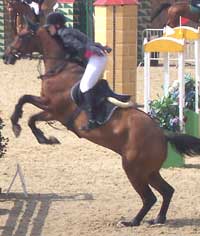
Equine Muscle Release Therapy For Horses
Article by Julie Dexter B.T.A, E.M.R.T, C.C.M.R.T - website
 We all know that horseswere not exactly made to carry
people on their backs, let alone perform at the levels we expect of them.
We all know that horseswere not exactly made to carry
people on their backs, let alone perform at the levels we expect of them.
Small wonder then that at some time in their career, most horses suffer some form of damage, either through injuryor wear and tear.
Add to this the fact that horses, being naturally prey animals, will attempt to mask any sign of weakness, that would leave them open to attack from predators, and you are left with a lot of horses struggling to perform.
The compensatory patterns then set up in the body, create unnatural forces on other muscles and limbs, which over the years become overworked and painful.
By this time the horse may start to show signs of physical distress or behavioural problems.
SYMPTOMS OF MUSCLE PROBLEMS IN HORSES
These include such symptoms as bucking or rearing; reluctance to jump; going disunited; difficulty in changing canter lead; intermittent lameness; resistance or becoming shut down and generally grumpy.
Treating only the area of apparent trauma will not produce the results we require, as we need to find and treat the route cause also.
This is all possible with a therapy called Equine Muscle Release.
E.M.R.T. is the only form of the Bowen technique accredited by the Bowen association of Australia.
Equine Muscle Release therapy works in a very gentle and non-invasive way by releasing muscle spasm. When muscles go into spasm, they not only restrict free movement but they also trap nerves and compromise the circulation.
This means that essential nutrients and oxygen do not reach the cells, and toxins build up in the horse's muscles.
Because EMRT works on the whole of the horses body, it may bring surprising benefits. For example, it also helps with restricted breathing (COPD), and growths such as sarcoids and warts may spontaneously disappear as the immune system is boosted.
We always ask you to check with your vet before commencing a course of treatments.
MANAGING CHRONIC CONDITIONS WITH EQUINE MUSCLE RELEASE THERAPY
The therapy is useful for managing even chronic conditions . A significant improvement is expected from three, sometimes less, treatments, speed of recovery depending on the age of the horse and how long the problem has been brewing.
The treatment itself will take 45-60 minutes with a thorough assessment of the horse beforehand.
EMRT practitioners undergo a rigorous two year training only open to experienced horse people, consisting of workshops, home study, case histories ,anatomy and physiology assignment and thorough examinations.
They carry full insurance,are members of the Bowen association of Australia ,and hold a first aid certificate.
Our final examination is validated by Alison Goward,who has spent more than 15 years developing the therapy and Dr. T.J. McEvoy QDAH(Hons), BVSc(Hons), MRCVS.
For more details or to discuss how EMRT may benefit
your horse call Julie Dexter B.T.A, E.M.R.T, C.C.M.R.T. on 0115
9179114 /07866 967282.
website
HORSE CARE ADVICE AND EQUESTRIAN ARTICLES
Kimberwick Bit | White Line Disease | Horse and Hound | Diarrhea in horses | Ragwort | Arthritis Supplements for Horses | Horse Bedding | Biotin for horses | Hoof care | Horse Insurance | Angleberry | Horse Feed Balancers | Equine Body Work | Devil's Claw | Bran mash | Hydrotherapy | Mud fever | Aubiose | Vegetable Horses | Liver disease | Calming Herbs | Buying a Trailer | Bot Eggs | Selenium | Horse Nosebleeds | Sticky Stifle | Headshaking | Horse Filled Legs Treatment | Contracted Tendons Foals | Sheath Cleaning | Weak Hoof | Hay Steamers | Melanoma in horses | Turnout Mountain Moorland | Waterford Snaffle Bit | Bit Fitting |